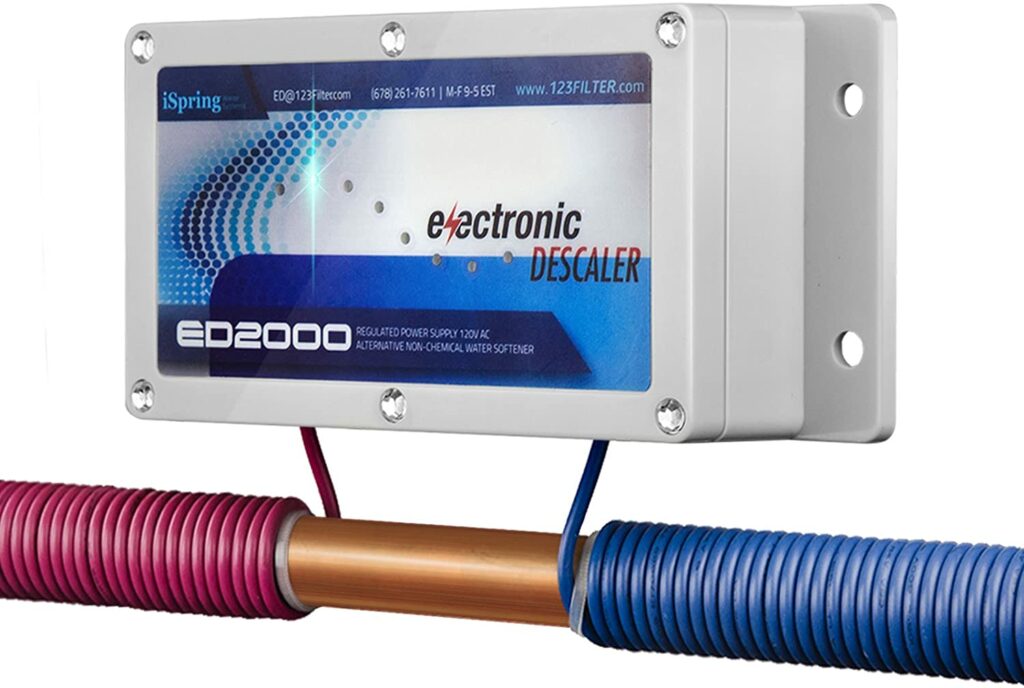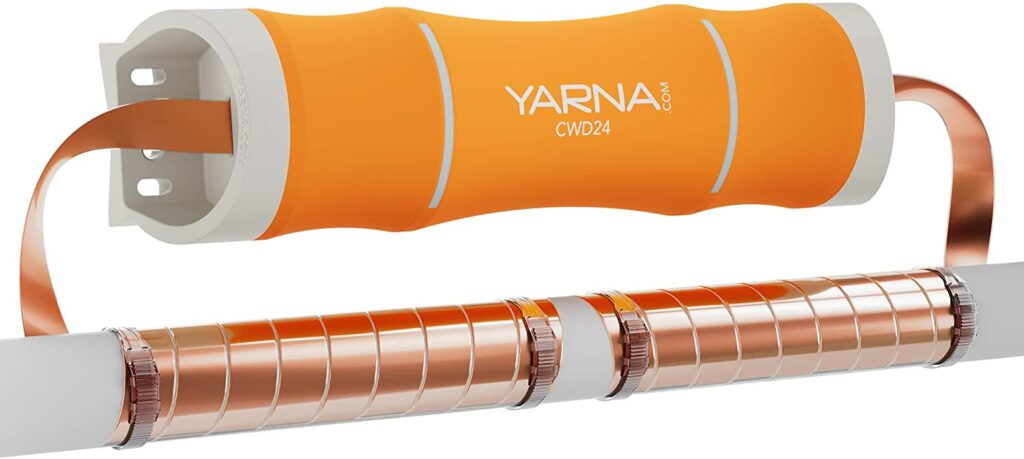A magnetic water softener, or a descaler, works by introducing a magnetic field through which the water then passes. The process of magnetic softening intends to reduce the hardness of water before it even enters to the home water system.
Most American households use salt-based ion-exchange water softener devices to deal with hard water. However, these devices are expensive, take up too much space, and are not eco-friendly.
A magnetic softener, on the other hand, can do the work of a salt-based softener in a more affordable, compact, and eco-friendly manner. Now, let’s see what this device is and how it works.
What is Magnetic Water Softener?
Magnetic water softener is a water-softening system that uses a powerful magnet to pull hard water mineral ions out of the water as it passes through a magnetic field. It can also alter the ions and help soften the hard water in your home.

Many people have to deal with the frustrations of hard water in their plumbing systems. Hard water has a high mineral content consisting primarily of calcium and magnesium. While this doesn’t make it a health hazard, it can lead to mineral buildup and subsequent clogging in the water pipes and limescale formation on appliances, laundry, and dishes.
One of the best things about a magnetic water softener is the fact it softens water without introducing chemicals to it, since, unlike other water softening solutions that rely on a chemical process to do their job, a descaler relies on the magnetic field.
Standard salt-based water softeners, for example, rely on a process referred to as ion exchange. In this process, negatively charged resin beads attract, trap, and replace hard water ions with sodium ions.
For this process to work efficiently, incoming hard water should spend some contact time with the resin beads. This means that a salt-based softener is likely to affect the flow rate of water.
Furthermore, the resin beads must be regenerated by a brine solution prepared in a separate tank to maintain their negative charge and sodium levels. In the end, the trapped minerals are flushed out of the system during the regeneration process.
However, this all relies on the use of sodium, and too much sodium has a negative effect on your immediate environment – it is bad for plants and garden, and it can cause soil degradation and even soil erosion. Since both the flushed water and the softened water itself are full of sodium molecules, ion exchange isn’t exactly an eco-friendly process.
Magnetic descalers don’t need sodium, regeneration, or even a tank to handle minerals, nor do they change the flow rate of the water. This is why they are a compact, affordable, low-maintenance, and eco-friendly alternative to conventional softening devices.
How Does a Magnetic Water Softener Work?
A magnetic water softener, or a descaler, works by directing the water flow through a magnetic field created by two strong neodymium magnets. These magnets remove or alter the water ions, eliminating their hard water properties and thereby making the water soft.
To this end, the magnetic descaler uses electromagnetic coils designed to separate the particles that make water hard. These particles – mainly calcium and magnesium – must come within reach of the magnets, which is why the magnets are attached to the pipes.
In that sense, the descaler relies on the conductivity of the pipes used at a particular home.
Do Magnetic Water Descalers Work?
Whether magnetic descaling was an effective water softening method was up for debate up until a 2014 study conducted with different water samples from the Colorado and Tempe rivers concluded that electromagnetic descalers could reduce scale formation by approximately 50%.

Of course, considering that the traditional salt-based water softening devices can remove almost all hard water minerals and eliminate scale and mineral buildup completely, this reduction rate is a bit humble.
But, if you take into account that magnetic descaling systems are more eco-friendly since they don’t release sodium, they make a worthy alternative to conventional methods. They are also affordable and low-maintenance because you don’t need to regularly add salt to them like you would need to with a water softener.
On the downside, magnetically-treated water is going to feel and taste different from other kinds of treated water, especially if you’re used to water that’s softened by salt-based devices. So getting used to a magnetic water softener may take some time.
If you need product recommendations for water descalers, refer to our article on the best water descalers.
How To Install a Magnetic Water Softener
Installing a magnetic water softener is reasonably simple if you follow the instructions provided by the manufacturer and understand your home’s plumbing system. Most of the time, the installation doesn’t require additional tools on top of what comes with the product.
Before you start, note that the magnets on each unit should be shipped and stored separately, and it’s essential to keep them apart throughout the process.
The first step is to place two of your system’s units on your cold water line, about six inches to a foot apart. While connecting the units to your cold water pipe, keep the back and front of the unit separated to prevent the magnets from snapping to each other. Once they stick together, it’s hard to get them apart again.
Once you have the units on your cold water pipe, tighten the wing nuts in place with your fingers.
If you have multiple hot water tanks in your home, you will then need to install one unit on each of these tanks. But it doesn’t get any harder than that – you can install the units on your hot water pipe in the same way you installed the two units on your cold water pipe.
When installing these units, remember to place them where they can do the most good for all the appliances in your home. In other words, you should install them at the main incoming water pipe to your house.
Conclusion
Unlike salt-based systems, magnetic descalers don’t use a chemical exchange process. Instead, they simply alter the molecular structure of minerals so that they can’t stick to surfaces and create scales or cause clogging in your pipes due to buildup.
Since these are very simple systems that solely rely on electromagnetic power, they don’t require tanks or run regeneration processes that consume lots of salt in the long run. This makes them quite affordable, compact, and eco-friendly, especially when compared to conventional softening options.
Thanks to their tankless setup and the fact they don’t require direct contact water, they don’t affect the flow rate of the water in your home. These properties also make them easy to install.
Hi,
I enjoyed reading your article. Question for you. I recently went on city water and replaced most pipes throughout house with plastic pipes. Only copper pipers are by heating unit. I have a rust issue. Have pipes that are rusting from inside out. Had a new Weil Mclain heating system installed and it recommends a softener or it will be damaged. Is using magnets going to make enough difference as a softener has been recommended by a plumber but I am not a fan of them.
Thanks for reading, Steve. The non-salt based alternative solutions can be effective. But, it ultimately comes down to how hard the water is that you’re dealing with and if processes like Template Assisted Crystallization (TAC) are going to meet your needs. Something like TAC is useful for making sure that water minerals don’t stick to your plumbing. But, again, if you’re also trying to “soften” your water and you have quite a bit of hardness, then it may not meet your needs.